| Uncials and The Development of Lower Case letters | |||
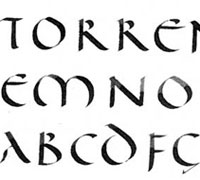 |
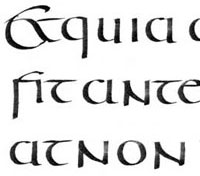 |
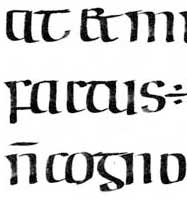 |
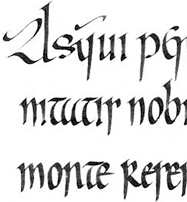 |
| Roman Uncials By the 4th century Roman letters were becoming more rounded, the curved form allowed for less strokes and could be written faster. “The uncial letter was used by the Greeks as early as the third century, BC...The Romans undoubtedly borrowed the style from this source and gave it the name uncials which is explained by the simple fact that these letters, in some of the early manuscripts containing them, were an 'uncia' or a Roman inch in height. Later uncials were far from uniform in height, but the name persisted.” 1 |
Roman Half-Uncials , 6th C Half-unicals were written between four guidelines allowing for the development of ascenders and descenders. This new style was easier and faster to write than the uncial style. “The history of uncials and half uncials is part of the history of the Christian church from the 4C through the 9C; they were essentially church letters. The association has been so strong that it has limited the usefulness of both designs to work having to do with ceremonies or festivities of a religious nature...There is no rule, however, which prevents their selection for other purposes; taste and discretion must decide.” 2 |
Half Uncials 7th, 8th and 9th C. While Roman half-uncials(or semi uncials) were written using a more comfortable or classical axis, in other regions uncials were written with a horizontally held pen nib. The Irish Half Uncial was imported into Ireland via Christian missionaries. See the Irish variant in the Book of Kells. |
English Half Uncials, 8th C. In England the uncial evolved into a more slanted and condensed form. While English and Irish uncials evolved, writing on the European continent devolved considerably and needed a reformer. Luckily it came in the Carolingian Handwriting Reform. (see next section. |
The Vespasian Psalter, an 8th century manuscript in Rustic uncials. See Larger 3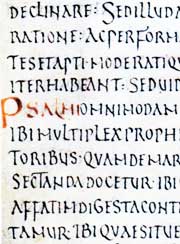 |
|
The Lindisfarne Gospel half uncials, c. 715. See Larger 4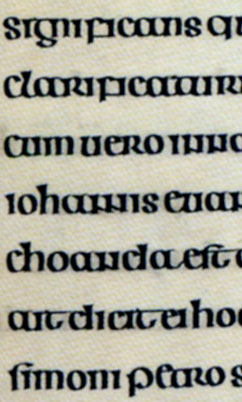 |
|
| Footnotes | |||
| 1, 2 Alexander Nesbitt, The History and Technique of Lettering. Dover Publications, 1957. |
A Short History of the Printed Word, Warren Chappell and Robert Bringhurst, Hartley and Marks, Vancouver, 1999. | 3 British Library, Cotton MS, Vespasian A. i. f. 3 4 BL, Cotton MS Nero D. iv, f. 208. |
|
| ©Designhistory.org 2011 | |||
